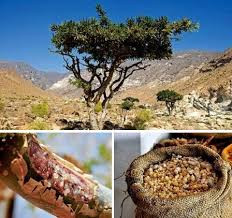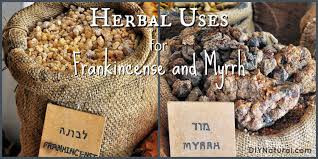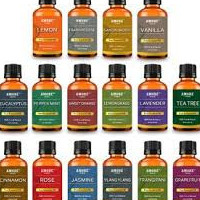
There are many trees throughout the world where their inner contents contain oils that can be extracted; in turn, these oils create a concentrated by-product referred to as an essential oil. An oil is referred to as essential if it contains the fragrance from a certain plant or tree that it came from. Essential oils contain aromatic compounds that are found throughout nature in many plants, including trees. These oils are referred to as VOCs or volatile organic compounds which means they convert from a liquid to vapor form when they are exposed to room temperature. When we use our sense of smell to take in different oils, it is tiny molecules of the vaporized oils, which are lighter than air, that are floating to get in our noses or olfactory receptors.
Essential oils have been scientifically studied for the ways they can alter our brain chemistry. This alteraction can affect our mental and emotional state; that is how they have been given therapeutic properties. Certain oils have certain therapeutic attributes for different types of ailments. Some of these oils can simply get inhaled to obtain these medical benefits, while others can be applied to the skin. Once applied to the skin they get absorbed into the bloodstream to create many other health benefits.
Where do essential oils come from 
Most of these oils are derived from different plants and trees throughout the world. The five most common essential oil producers are Brazil, the United States, India, France, and China. It is reported that essential oils have been around and used for treating ailments in humans and animals for roughly 5,000 years. Many of these countries have certain endemic species of plants so the oil can only get derived from where it is found.
Two of the oldest essential oils come from the bark of desert trees in North Africa, The Middle East, India, Omen, and Yemen. These include Myrrh or Commiphora tree (Commiphora Sp.) where 190 species of trees that contain this oil exist. The other is Frankincense or Boswelia tree (Boswelia serrata) where 20 or so species of these trees that contain this oil exist.
There is a biblical story that talks about the three wise men bringing gifts of essential oils to baby Jesus. Two of these gifts were Myrrh and Frankincense while the other was gold. However, even then 2022 years ago, Myrrh and Frankincense were rumored to be worth their weight in gold.
How essential oils made 
The method of making essential oil that dates back the longest, while being the most common today, is steam distillation. To do this you take the plant material, then put it in a sealed device such as a still, then you force hot water through the unit. This creates condensation in the still which causes vapor that then turns into a liquid to where it gets bottled
Another method is cold pressing the plant material such as the leaves, flowers, bark, roots, or fruit through a device which also causes condensation that turns into vapor. This method freezes the material with ice which leads to liquid oil. Cold compression is most commonly used when making citrus essential oils because they have a waxy rind that resists heat.
Another method for extracting plant materials for essential oil production is by CO2. This makes the temperature of the carbon dioxide go somewhere between a gas and liquid state to create a safe extraction for any delicate plant parts.
A cool fact is that essential oils extracted are 80 % more potent than any dried herb.
There is a technique called the rain drop massage where you mix a variety of young living essential oil varieties at various places around the body that support the body to come back into balance. If you have never had one I highly recommend it.
Why nature created essential oils
Nature has created essential oils for many reasons including to ward off a disease that is often caused by bacteria, fungi, or viruses. They are also created by plants in nature so that many animals and insects won’t eat them so they can survive. The aromatic features attract pollinators such as bees, wasps, hornets, and flies which help the plants reproduce. Mother nature additionally created these oils so they can make the soil toxic to other plants that may otherwise compete in their space for nutrients, sunlight, and moisture.
MOST essential oils can be put in a diffuser to enhance the scent and air quality in our homes.
Health Benefits of trees
When it comes to the health benefits of essential oils the list is long with over 100 different essential oils being sold. Some of these health benefits include
-boosting the immune systems
-relieving headaches
-reducing inflammation
-relieving nausea
-relieving pain
-relieving anxiety
-Killing, bacteria, viruses, and fungi
-improving sleep
-clearing the sinuses to breathe clearly
-increased focus and alertness
-better mood
Trees that have essential oils and their benefits
When it comes to trees and essential oils the list is vast:
–Frankincense (Boswelia serrata) 
– fights certain cancers
-maintains oral health
-improves asthma
-Improves gut function
-reduces arthritis
-reduces pain and inflammation
Myrrh (Commiphora sp.)
-controls spasms and restless leg syndrome
-kills parasites
-it’s a powerful antioxidant
-combats pain and swelling
-supports skin health and heals sores
-supports oral health
-Kills harmful bacteria
Tea Tree comes from the Australian Melaleuca Tree (Melaleuca alternifolia) that has been used for centuries to combat fungi, viruses, and bacteria. Here is a list of 11 uses for tea tree oil:
-FIGHTS ACNE
-Insect repellent
-Antiseptic
-boosts wound healing 
-mouth wash
-all-purpose cleaner
-decreases inflammation
-controls dandruff
-treats athletes’ foot and jock itch
– Kills mold on fruits and vegetables
-relieves psoriasis
Other essential oils from trees include
–Arborvitae– (Thuja oxidentalis) is a powerful cleansing and purifying agent, It also has the ability to inspire a sense of peace and calm feeling.
–Birch– (Betula sp.) can lower a fever by promoting sweating, tighten the appearance of the skin by reducing wrinkles and sagging of the skin. Strengthen the hair and gums, ease joint pains and arthritis, has astringent properties, that can tighten the skin
–Cedarwood– (Cedrus sp.) is used for repelling insects, deodorizing indoor environments, it prevents the development of mildew or mold, clears the mind to create enhanced concentration while improving cerebral activity.
–Eucalyptus– (Eucalyptus globulus) relieves tension and stress, clears breathing and airways, Soothes sore throats, keeps away insects and bugs, controls and silences coughs, disinfects wounds, freshens breath, controls blood sugar, controls allergies, plus boosts immune health.
–Balsam fir– (Abies balsamea) has a wonderful aromatic essence, is anti-inflammatory, antibacterial, promotes a restful night’s sleep while reducing anxiety.
–Bald Cypress– (Taxodium distichum) Also relieves anxiety, is a natural deodorant, eliminates respiratory conditions, has a blood clotting effect, aids in the removal of toxins, treats muscle soreness and cramps, heals wounds, treats varicose veins and cellulite.
–Douglas fir– (Pseudosuga menziesii) A great oil for the skin because it has purifying and aromatic features, is a great cleaning agent, has a wonderful sweet pine-like scent.
–Sandalwood– (Santalum album) lowers stress, creates a relaxing calm effect to improve quality of sleep, improves mood and attentiveness, A great natural perfume.
–Spruce– (Picea sp.) was used by native Americans for purifying the body and cleansing rituals, makes a person calmer, boosts our immune systems, improves our quality of sleep, helps to release emotional blockages, makes you more aware and alert, helps set the mood
–White fir– (Abies concolor) increases energy levels, improves our moods, treats respiratory infections, strengthens the immune systems, boosts heart health, reduces pain while reducing inflammation, promotes healing.
–Scotch Pine– ( Pinus Sylvestrus) is great to heal gout, treats muscular pain and fatigue, relieves and reduces arthritis and rheumatism, is good for clearing the sinuses and clearing the respiratory systems, fights off common colds and flu, aids in relieving coughs.
–White pine– (Pinus Strobus) is used to treat coughs, asthma, bronchitis, colds, sinusitis, wounds, and kidney disorders
–Juniper– (Juniperus communis) is used to numb pain and treat bronchitis and asthma, Used to make Gin, Used for flavoring foods and beverages.
–Petitgrain– (Citrus aurantium) Helps ease the feeling of tension, so it calms the nervous system and promotes restful sleep, At night you can put a few drops of lavender and petitgrain oil on your pillow for an aromatic enhanced restful night’s sleep. Use in a diffuser for a relaxing calming aroma as well.
–Clove (Syzygium aromaticum)- This is an evergreen tree native to the Maluka islands in Indonesia. The benefits are high in antioxidant properties, boosts immune function, has antibacterial and antimicrobial properties, enhances and boosts our sex drive, relieves oral pain, a remedy for acne, relieves an upset stomach, treats candida infections throughout the body, increases blood circulation, can prevent ulcers, will aid in better heart health, can control diabetes.
–lime– (Citrus aurantiifolia) can treat infections, both bacterial fungal and viral, relieve toothaches, a powerful disinfectant, can reduce a fever, headache, or earache, promotes blood coagulation, can restore bad health, can prevent signs of aging.
–Orange– (Citrus sinensis)– anti-cancer, antimicrobial, relieves anxiety and depression, pain relief, enhance exercise performance, helps with weight loss, helps with insecticide activity, can treat spasms, has sedative effects, has aphrodisiac properties, relieves inflammation, relieves erectile dysfunction, acts as a cholagogue to promote secretions in the appropriate glands for the exocrine and endocrine systems, relieves depression, can stimulate urination to clean the bladder, acts as a tonic, has carminative properties, improves cognitive function.
–lemon- (Citrus limon) can reduce anxiety and depression, Improve the appearance of our skin, treat acne, help us to feel more energized, improve cold and flu symptoms, relieves pain, heal wounds, eases morning sickness.
– d-limonene – is made from orange peel extracts and has many health benefits as well. Here are a few, Anti-cancer, clears bronchitis, treats diabetes, removes and loosens gallstones, treats gastroesophageal reflux disease (GERD) by strengthening the lower esophageal sphincter (LES), treats heartburn, lowers high cholesterol, treats inflammatory bowel disease (IBD), treats metabolic syndrome, lowers obesity by stimulating and enhancing are metabolism, treats peptic ulcers.
*** Another one of my favorite essential oils is called parasympathetic and is made with a combination of clove, and lime essential oils. This activates the body’s natural ability to heal by stimulating our body’s parasympathetic nervous systems, which is the “rest and digest systems” in our body’s for optimal digestion, detoxification, and immune function. Apply over vagus nerve behind the ear lobe on the mastoid bone.
Conclusion
The list I provided here is just the tip of the iceberg for the vastness of medical health benefits that essential oils provide. I keep a rack of essential oils in my home and have been using them for a vicennial. By simply placing a few drops of essential oil in a diffuser you can create a healthy aromatic scent enhanced household. With all the varities of oils you can change the mood from day to day with enhancements to your health and well-being. My sincere desire is that you enjoyed the content in this article about essential oils that come from trees. If you have any questions or comments please leave one or drop me an email.


Great article Nathan. I’ve been using essential oils for years now. It’s my medicine cabinet! Loved how you listed so many oils and their use.
Keep up the great work!
Hi Amy thanks for the comment. I am glad that you liked the article. Where are you from?